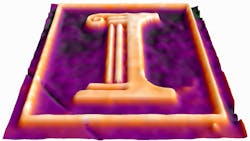Champaign, IL--A new low-cost method that carves delicate features onto semiconductor wafers using light, and then watches the process as it happens, has been developed by University of Illinois (U. of I.) researchers. "You can use light to image the topography and you can use light to sculpture the topography," said electrical and computer engineering professor Gabriel Popescu. "It could change the future of semiconductor etching." Semiconductors are commonly shaped by etching with chemicals. Etching errors, such as residual layers, can affect the ability to further process and etch as well as hamper device performance. Thus, researchers use time-consuming and costly processes to ensure precise etching--for some applications--to within a scant few nanometers.
The new technique can monitor a semiconductor’s surface as it is etched, in real time, with nanometer resolution. It uses a special type of microscope that uses two beams of light to very precisely measure topography. "The idea is that the height of the structure can be determined as the light reflects off the different surfaces," said electrical and computer engineering professor Lynford Goddard, who co-led the group with Popescu. "Looking at the change in height, you figure out the etch rate. What this allows us to do is monitor it while it's etching. It allows us to figure out the etch rate both across time and across space, because we can determine the rate at every location within the semiconductor wafer that’s in our field of view."
The new method is faster, lower in cost, and less noisy than the widely used methods of atomic force microscopy or scanning tunneling microscopy, that cannot monitor etching in progress but only compare before and after measurements. In addition, the new method is purely optical, so there’s no contact with the semiconductor surface and the researchers can monitor the whole wafer at once instead of point-by-point. "I would say the main advantage of our optical technique is that it requires no contact," Popescu said. "We're just sending light, reflected off the sample, as opposed to an AFM where you need to come with a probe close to the sample."
Traditional chemical etching creates features in steps or plateaus. For curved surfaces or other shapes, semiconductor researchers use photochemical etching, wherein light shines through very expensive glass masks that have distinct patterns of gray to let light through by degrees. A researcher must purchase or make a mask for each tweak of a pattern until the correct pattern of features is achieved. By contrast, the new method uses a projector to shine a grayscale image onto the sample being etched. This allows the researchers to create complex patterns quickly and easily, and adjust them as needed. "To create each mask is very expensive. That's impractical for research," Goddard said. "Because our technique is controlled by the computer, it can be dynamic. So you can start off etching one particular shape, midway through realize that you want to make some change, and then change the projector pattern to get the desired outcome."
The researchers envision this technology applied beyond etching, to real-time monitoring of other processes in materials science and life science--for example, watching carbon nanotubes self-assemble, or error monitoring during large-scale computer chip manufacturing. It could help chip manufacturers reduce costs and processing time by ensuring that equipment stays calibrated.
SOURCE: University of Illinois; http://news.illinois.edu/news/12/0928etching_LynfordGoddard_GabrielPopescu.html

